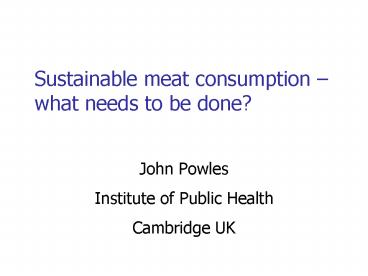Sustainable meat consumption what needs to be done PowerPoint PPT Presentation
1 / 27
Title: Sustainable meat consumption what needs to be done
1
Sustainable meat consumption what needs to be
done?
- John Powles
- Institute of Public Health
- Cambridge UK
2
Context 1
2007
- To avoid dangerous climate change, GHG
emissions will need to be reduced by - Half per global citizen
- by 2050
- Three quarters per unit income
(To achieve stabilisation at 550 ppm CO2e)Stern,
p 205
3
Context 2
- Proportionately greater reductions will be
needed in high income countries to allow room
for the effects of increased incomes in low and
middle income countries - eg 80 targets for total emissions from EU
4
Context 3
- Livestock production is a leading source of
GHG emissions (more than transport) - And, on business as usual assumptions, is
- on a steep upward trajectory
- expected to at least double by 2050
- Because, until now
- (eg elasticity of demand for beef in China is
1.5 (Kaaresvirta et al, 2008))
affluence ability to eat more meat
5
Context 4
- However, Nicholas Stern, when considering the
role of demand reduction - Limited his suggestions to
- over-heating buildings ... Energy-hungry
appliances ... Environmentally unfriendly forms
of transport etc (p 219) - And did not pay attention to health gains
- among the co-benefits of measures to avert
climate change (ch 12) - apart from reduced air pollution
6
Suppose
- The link between affluence and high levels of
meat consumption - Is allowed to be mutable
- In an evolving world where the meaning of
affluence must in any case - change radically
towards affluence that can be sustained - (who defends affluence that cannot be sustained
?)
7
Question
- What changes in consumption might be needed
just to achieve the conservative objective of
averting an increase in GHG from global livestock
by 2050?
8
Global greenhouse gas emissions (2000)
Livestock production (including feed production)
accounts for half of all non-energy emissions
From Stern (2006)
9
Sources of greenhouse gas emissions from
livestock production
Methane from cattle, sheep and goats front and
back ends
includes feed production and associated land
use changes
Based on FAO 2006
10
90 gms meat per da
Per-person income (US PPP)
11
Levels of meat consumption by region
- Region Meat consumption
(g/person/day) - Africa 31
- East and South Asia 112
- West Asia (incl. Middle East) 54
- Latin America 147
- Developing countries, total 47
- Developed countries, total 224
- World average 101 g/d
- Note
- Actually amount available for consumption.
Quantities actually ingested will be lower,
especially in high income countries, where
wastage is higher. - 80-100 gms of meat beef pattie in regular
hamburger. An American quarter pounder 115
gms of meat.
12
Recent and Projected (to 2050) Consumption of
Livestock Products
Projections
Industrialised
Ex-Soviet bloc countries -in-transition
East Asia
Latin America, Caribbean
Near East, N Africa
South Asia
Sub-Saharan Africa
Year
Source Livestocks Long Shadow. FAO, 2006
13
Preventing an increase in GHG emissions from
livestock to 2050 illustrative multipliers
- Max
- acceptable Popn mitigation av.
consumption - Overall
- 1 1.4
14
Preventing an increase in GHG emissions from
livestock to 2050 illustrative multipliers
- Max
- acceptable Popn mitigation av.
consumption - Overall
- 1 1.4 0.8 ?
15
Preventing an increase in GHG emissions from
livestock to 2050 illustrative multipliers
- Max
- acceptable Popn mitigation av.
consumption - Overall
- 1 1.4 0.8 0.9
- Current av. consumption 0.9 90 g/d
16
90 gms meat per da
Per-person income (US PPP)
17
90 gms meat per da
Per-person income (US PPP)
18
90 gms meat per da
Convergence
Per-person income (US PPP)
19
Potential co-benefits to health of a global
convergence (over 40 years) to a mean daily meat
consumption of 90 g
20
Caveat
- In most diets, inadequate consumption of
beneficial dietary components appears to be
more detrimental than is an excessive intake of
harmful foods - Walter Willett, Harvard
- Ie Less meat implies more space for protective
components of diet - gt Probable source of main health benefits
21
(No Transcript)
22
- Have any previous generations had to embrace
radical institutional and behavioural change - ... In order to make progress sustainable?
23
Overcoming the urban penalty, 1-4 year olds,
Sweden, 1860s 1920s
24
- It took 60 years to make city life safe for
Swedish children - Culminating in programmes that changed the
(private) behaviours of parents in caring for
their children
25
- Is our right to eat lots of meat more
inviolable than our right to be indifferent about
personal and family cleanliness? - Or are both rightly seen as obstacles to
sustainability?
26
Summary
- Livestock should not be ignored in strategies to
avert global warming - Limited prospects for mitigation (reducing GHG
emissions per unit product) mean emphasis must
shift to restraining global consumption - A global convergence to around 90 g meat /d seems
to be needed to avoid GHG increases from this
sector by 2050 - Such a convergence should also bring health
co-benefits to both current high and low
consumers
27
(No Transcript)

